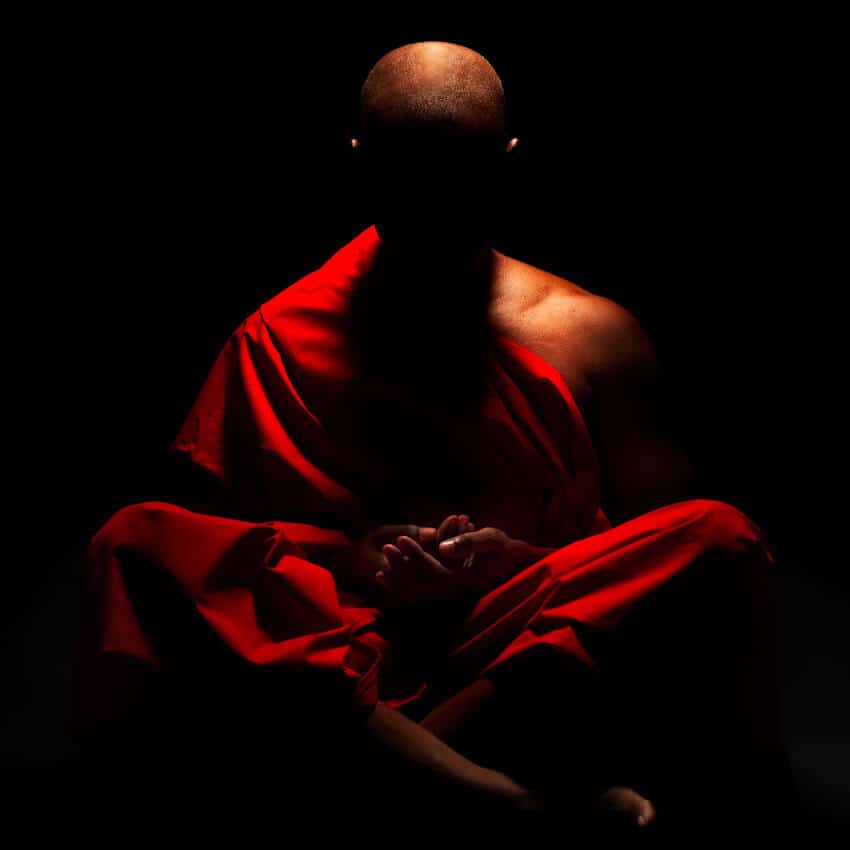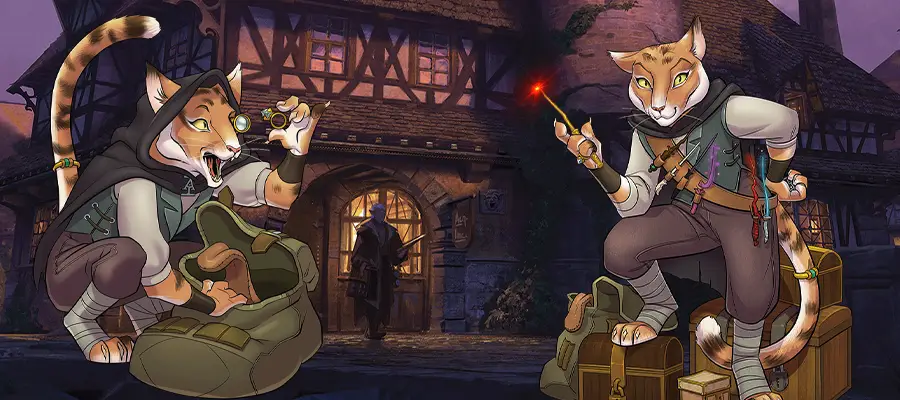Featured Way of Shadow Monk image credit “Monk” by IamTheWay. Creative Commons Attribution 3.0 License.
Disclaimer: This article contains affiliate links that add gold to our coffers.
The Way of the Shadow Monk was introduced in the Player’s Handbook. It’s the ninja Monk and has features to help you move rapidly and silently through darkness.
This review will take a rummage into the Shadow features. I’ll see how the subclass functions with the core Monk class features. I’ll also assess feat, race, and multiclass options, and finally combine all these into some build concepts.
As always, these are just my thoughts. Please share your ideas for Way of Shadow. I’d love to hear about them in the comments below!
Reviewing the Shadow Monk Class Features
Let’s begin with the abilities obtained by a Shadow Monk. I have reviewed them one by one in great detail. As an overall note, it’s unfortunate when a Monk subclass requires the use of ki points to use its skill. I say it’s unfortunate because it forces a player to choose between the base Monk features and the subclass features. There aren’t enough ki points built into the Monk to do both. Fortunately, not all subclass features are draining to the ki supply.
3rd Level – Shadow Arts
When you take The Way of the Shadow at level three, you learn some spells. Your spellcasting costs two ki points. This ki cost is expensive at level three. You only have three ki points per short rest. The cost seems less expensive at higher levels when you have more ki points.
You also gain the minor illusion cantrip, one of the most fun and flexible cantrips in the game.
Shadow Arts Spells:
- Darkness – a 15ft radius sphere of magical darkness, 10 min duration, 60ft range, requires concentration
- Hello darkness my old friend, I’ve come to talk to you again…
- You can’t see through this, so it’s only useful for obscurement. Finding a way to see through magical darkness is premium for this subclass.
- Pass Without Trace – 1 hour duration, +10 bonus to Stealth checks to everyone within 30 feet, needs concentration.
- …because a vision softly creeping, left its seeds while I was sleeping…
- Makes your whole party stealth ninjas, fantastic spell.
- Even your clankies can pass stealth checks.
- Darkvision – 8 hour duration, 60ft darkvision.
- …and the vision that was planted in my brain, still remains…
- Doesn’t let you see through your own magical Darkness.
- You should probably find another way to get darkvision and save your ki points for the other spells.
- Silence – 10 minute duration, 20ft radius sphere, deafens everyone, makes spells with verbal components impossible, requires concentration.
- …within the sound… of silence ?
- This can completely shut down spellcasters. Unfortunately this is a stationary effect, so an affected creature can just walk out unless prevented from doing so – by grappling or someone using area of effect spells that affect movement.
- Given that silence takes an action to fire off, it can be a bit tricky to keep your target mage in place. You may need to run them down, grapple them and drag them screaming back to your silenced area. Once in Silence, nobody can hear you scream.
- Stunning Strike is also a great option for shutting down spellcasters, but Silence is more reliable.
- Bear in mind that some spells don’t have verbal components (Hypnotic Pattern for example) so will work just fine in Silence.
- All teleportation spells do have verbal components, so these can’t be used to escape Silence
- You can cast Silence in a room then messily and noisily murder the person there and nobody in the adjoining room will hear a thing. This can be useful during infiltration missions, or for framing perfectly innocent members of the local council who won’t accede to your perfectly reasonable demands.
- You can cast Silence on the room where the party Bard is conducting sensitive negotiations to keep your party from being banished to the outer planes of existence, just for a giggle.
Additional Notes about Shadow Arts:
- It may be worth investing in Athletics proficiency (or even expertise) for grappling, to get the most out of your Silence ability. This can make you a bit of a mage killer.
- Darkness can be portable – it’s cast on an object and can be controlled by covering/ uncovering that object. A favorite trick here is to cast Darkness on a coin in a shuttered lantern, and just turn it on and off as needed.
- Unlocking the true power of the dark(ness) side requires the ability to see through magical darkness. This used to be quite hard to find but Tasha’s Cauldron of Everything has provided a few more options (see later).
- If you can see through magical darkness you can use it with your 6th level Shadow Step. You also get advantage on all your attacks and enemies get disadvantage on all theirs.
- Bear in mind that neither Darkness nor Silence are party-friendly
- You can cast Silence on party members or arrogant NPCs out of combat if they are boring you
These abilities are unique among Monks and open lots of new possibilities for a Shadow Monk.
6th Level – Shadow Step
You get a new bonus action – you can teleport up to 60ft from one area of dim light or darkness to an unoccupied space you can see in another area of dim light or darkness. You then get advantage on your first attack.
This is an amazing ability. You have to have darkvision at least (you can give it to yourself with the spell if necessary). Your vision is even better if you can see through your own magical Darkness spell/ One of the biggest criticism of this subclass is that it can’t see through magical darkness or gain darkvision on its own. Seeing through your magical darkness will allow you to use that darkness as the start or endpoint for the teleport.
This doesn’t cost any ki points, you can do it every round, and it gives you an insane amount of mobility on top of the Monk’s already impressive movement speed.
In my view, this is the strongest level 6 Monk ability.
11th Level – Cloak of Shadows
When in dim light or darkness, you can use your action to become invisible. You will remain invisible unless you attack, cast a spell, or enter an area of bright light.
- You can Shadow Step and remain invisible.
- If you already have a spell running it will continue to run.
- If you have proficiency/expertise in Stealth (potentially boosted via Pass Without Trace) you will be extremely hard to find, even more so if you are teleporting around.
- While invisible you can either use the Help action to grant advantage to your allies’ next attack roll, Use an Object or Activate an Item without losing your invisibility.
- If your DM lets you play a Grung you can go around touching multiple enemies and giving them the poisoned condition all without breaking invisibility
This is an amazing ability for scouting and infiltration. It has fantastic synergy with Darkness, Pass Without Trace, Silence, and Shadow Step. You should definitely be picking up Stealth proficiency with the Shadow Monk.
17th Level – Opportunist
Whenever a creature within 5ft of you is hit by an attack by a creature other than you, you can use your reaction to make an opportunity attack.
This is a really underwhelming 17th level ability. You are more likely to be picking off isolated targets (the enemy mage) than being in the thick of combat with your allies.
Shadow Monk Subclass Summary
The Shadow Monk features are useful and impactful – your movement and stealth abilities are exceptional. You don’t do well in bright sunlight, so make sure you’re in a campaign and party that concentrates on dungeons, night fighting, or the Underdark.
Feat Options for Shadow Monks
The standout feat for this Monk is the new Eldritch Adept from Tasha’s. This will allow you to pick up the Devil’s Sight invocation and see 120ft through magical (and non-magical) darkness. Note that you should have the ‘spellcasting trait’ as a prerequisite, and although you can cast a few spells as a Monk, you lack this trait. Your DM might allow you to take the feat anyway; if not, you’ll need a level or two in another class to pick up the trait.
My favorite feat for most Monks is Mobile, allowing you to avoid opportunity attacks from a single enemy you have attacked and boosting your movement speed. It works well on a Shadow Monk too.
If you go with an Elf for your race, then Elven Accuracy is a great feat. You have at least one consistent method of generating advantage (especialy if you can see through magical darkness). This feat allows you to reroll one of the two dice you roll with advantage, increasing chances of landing a hit.
Fighting Initiate may be an option for the Blind Fighting Style – the main issue here is that blindsight only has a range of 10ft and the Darkness spell has a radius of 15ft, so if you want to carry your Darkness around with you (for the combat bonuses), you won’t be able to see your next target or destination for Shadow Step, as there’ll still be a ring of Darkness around you. You could cover the source of Darkness so you can see further than 10ft, but then you might not be in darkness anymore and unable to Shadow Step. You could leave your Darkness behind, but then you’ll lose the combat benefits. It just doesn’t work quite as well as Devil’s Sight.
Race Options for Shadow Monks
Custom Lineage gives you that free feat, and given how feat-starved Monks can be, this can also be a great way to get started as a Monk. Custom Lineage is favored over Variant Human because it provides darkvision.
The extra 5ft reach you can get on your own turn with a Bugbear is great on any Monk that likes to make hit-and-run attacks. Bugbears get darkvision and Stealth proficiency too.
Dwarves, Elves, and Hobgoblins make good race choices if you use Tasha’s new Monk feature, Dedicated Weapon. You can negotiate the weapon proficiencies gained from these races with your DM to be swapped out for tool proficiencies to avoid redundancies in your skillset. Dedicated Weapon proficiencies can be swapped out for one or more weapons of choice and give you a 1d10 versatile weapon attack die for your main attack.
Given that you want to avoid sunlight as a Shadow Monk (most of your best abilities only work in dim light or darkness), selecting a race with sunlight sensitivity makes sense, opening up Drow, Duergar, or Kobold as interesting options.
Tabaxi characters receive a fantastic speed boost for even more maneuverability. They get darkvision (critical for a Shadow Monk), Stealth proficiency (makes thematic sense), and unarmed strikes that do slashing damage (interesting option for unarmed strikes).
Multiclassing for Shadow Monks
Because the 17th level ability is so underwhelming, this subclass lends itself very well to multiclassing. It’s probably the most multiclass-friendly of all the Monks.
I like dipping a level or two of Cleric for my Monks. Most Monks don’t have anything to do with their concentration and a level of Cleric allows you to be a bit more versatile. The Twilight Domain is an amazing fit for a Shadow Monk with its insane shared 300ft darkvision and portable dim light for one minute via the Channel Divinity. You get spellcasting for Eldritch Adept too, and the standard suite of useful Cleric abilities and spells. You even get martial weapons. A lot of D&D groups don’t allow the Twilight Cleric because it’s so overpowered.
Rogue is a great option: extra proficiencies, Expertise in Stealth and Athletics, and Sneak Attack. Cunning Action at level 2 can free up ki points from your bonus action options, and Assassin or Arcane Trickster at level 3 are great options for a Shadow Monk. The latter provides you with spellcasting for Eldritch Adept.
Ranger is the other standout option. Two levels of Ranger gets spellcasting and a Fighting Style. I’m not fond of Blind Fighting for a Shadow Monk, which I’ll explain when I get to feats. Favored Foe and Canny (grant Eexpertise in a skill). Progressing to a third level in Ranger gets you the Gloom Stalker subclass. This gives you perks in the first round of a fight, including a Wis mod bonus to Initiative, a 10ft movement speed boost, and an extra attack with 1d8 bonus damage.
Gloom Stalker Ranger / Shadow Monks can Shadow Step to gain advantage for the extra attack when combat begins. You also gain the amazing Umbral Sight, which will give you darkvision if you don’t have it (or extend your existing darkvision range by 30ft). This will make you invisible to creatures with darkvision while you’re in darkness. Rangers also get spellcasting, qualifying them for the Eldritch Adept feat to gain Devil’s Sight.
You can also multiclass to Warlock for Devil’s Sight, but the stats don’t match up well. Hexblade multiclassing is a colossal, overdone bore.
Shadow Monk Build Ideas
There are so many fun options for the Shadow Monk I can’t pick a favorite.
For my build on my Shard YouTube channel, I went with Twilight Cleric 2, Shadow Monk X, a Tabaxi, and Eldritch Adept for Devil’s Sight.
Shadow Monk 6, Gloom Stalker 3, Assassin 3 is definitely a thing.
You can create a grappling mage killer. A Duergar’s Enlarge option (from Enlarge/Reduce) grants you advantage on Athletics checks. Take at least one level of Rogue for Expertise in Athletics (and Stealth) and start with at least a twelve in Strength. Even without a substantial Strength stat, your Athletics Expertise will give you a huge advantage when grappling most spellcasters. This build would not use Darkness so much, opting instead to concentrate on Silence, being stealthy, and sneaking/teleporting behind the enemy mage before springing into action. The Mage Slayer feat would round it out nicely.
For a pure, stone-cold, merciless killer, you could play a character called Tzzird (the anti-Drizzt) and go for a Drow. A Shadow Monk Gloom Stalker, terrifying not to behold in the Underdark (you’d never know where he is). Again taking Eldritch Adept, but this time also adding Elven Accuracy, with expertise in Stealth. You can dispose of victims in pitch darkness and absolute silence.
For the most fun (and/or if your party needs a Rogue), I’d probably go with a Bugbear Arcane Trickster Shadow Monk. The extra reach is great on a hit-and-run then fade-back-into-the-shadows character; you get Stealth and darkvision with the Bugbear, plus a nice damage bonus for surprise attacks. Expertise in Stealth is a must. The Shadow Monk gets a few ways to guarantee advantage, which means a lot of Sneak Attack damage (with reach) when you reach level three in Rogue. An Arcane Trickster becomes a spellcaster, so you can add Eldritch Adept for Devil’s Sight as well as useful cantrips and spells. Cunning Action is great for your ki economy (bonus action Dash and Disengage become free) and gives bonus action Hide.
Most of these builds take a little while to be fully realized. You need six levels in Shadow Monk for the amazing teleports and between one and three levels in your multiclass to get all your abilities online. From that point on, you can choose whether to continue with your path as a Shadow Monk. If you’re going to be a Monk mainly, I recommend getting to at least Monk level fourteen for the amazing saving throws, or continue your path with your other class(es).
Summary of the Way of Shadow Monk Subclass
The Shadow Monk offers a unique playstyle for a Monk. The mobility you have is off the charts. You won’t do so well in talky, political, negotiation-based campaigns (unless covert assassination is required). Campaigns taking place in a savanna’s broad daylight would be bad, too. Campaigns with shadows skulking are your domain, and there you reign supreme.
This wraps up my review of the Way of the Shadow! Check out more of my subclass reviews here on FlutesLoot.com. You can find a collection of my work here. You can also read all of FlutesLoot’s content about Monks right here. Enjoy your adventure this weekend!




